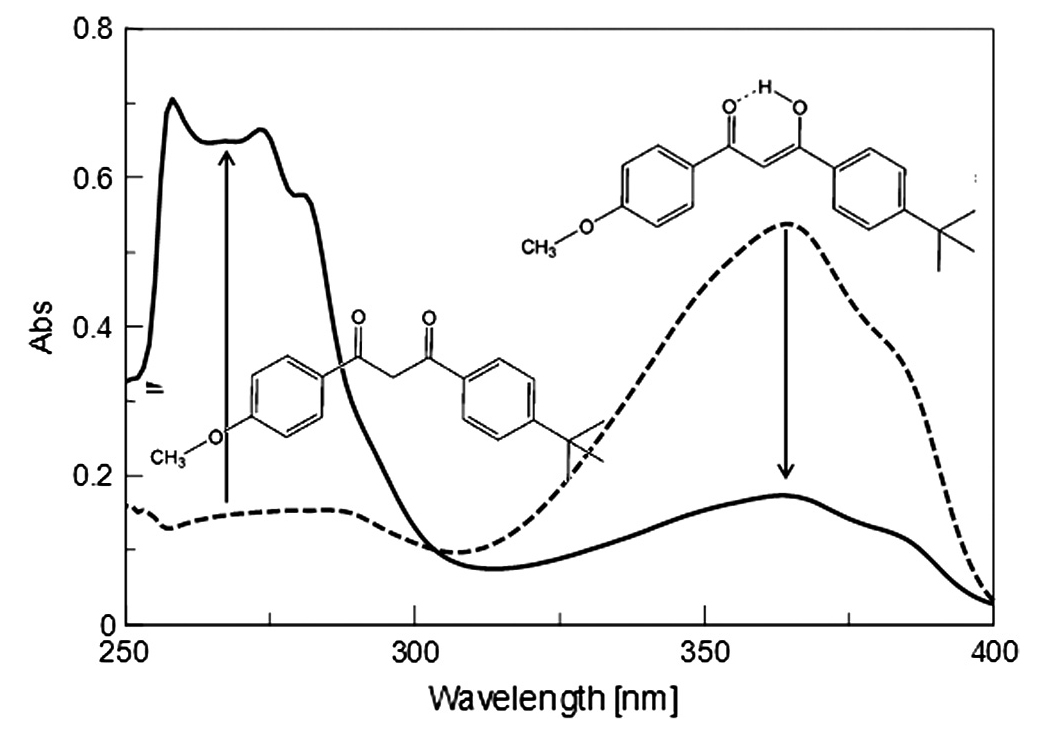


INCI name: butyl methoxydibenzoylmethane
Synonyms: 1-[4-(1,1-dimethylethyl)phenyl]-3-(4-methoxyphenyl)propane-1,3-dione
Molecular formula: C20H22O3
Molecular weight: 310.39 g/mol
IUPAC name: 1-(4-tert-butylphenyl)-3-(4-methoxyphenyl)propane-1,3-dione
CAS number: 70356-09-1
EC number: 274-581-6
Avobenzone is a UVA solar filter that is globally approved for sunscreen use. It should be noted, that it is currently the only UVA sunscreen approved by the U.S. Food & Drug Administration (FDA).† While avobenzone provides very good coverage in the UVA region of the electromagnetic spectrum, it has issues with instability because it degrades during exposure to UV radiation. To demonstrate, Figure 1 contains UV absorption spectra for avobenzone in DMSO before and after two hours of radiation. Notice how the peak at approximately 365 nm (UVA region) decreases in intensity after UV irradiation, which is accompanied by an increase in the peak at ca. 260 nm (UVC region).

Figure 1: UV absorption spectra of avobenzone in DMSO before (dashed line) and after (solid line) irradiation. Conversion of the avobenzone structure from the keto form (molecule on the left) to the enol form (molecule on the right) is thought to occur due to UV irradiation. Reprinted from S. Afonso et al., Photodegradation of avobenzone: stabilization effect of antioxidants, J. Photochem. Photobiol. B, 140, 36-40. Copyright (2014), with permission from Elsevier.
Changes in the UV absorption spectrum of avobenzone after exposure to UV radation are well established and occur due to photoisomerization in which the enol form of the molecule is transformed to the keto form.1,2 The enol form absorbs in the UVA region while the keto form absorbs in the UVC region. It should be noted that the stability of avobenzone depends on its solvent.3 For example, avobenzone is photostable in polar protic solvents (e.g., methanol), but is not photostable in polar aprotic solvents (e.g., DMSO). Studies have shown that mineral oil and isopropyl myristate are suitable solvents for ensuring the photostability of avobenzone.4
In addition to carefully selecting the sunscreen solvent, there have been considerable efforts to stabilize avobenzone by combining it with photostabilizers.5-7 In fact, L’Oréal has a patent on the stabilization of avobenzone by octocrylene (another sunscreen), which expires in 2016.8,9 In addition to octocrylene, there are a number of other molecules available as stabilizing agents including: diethylhexyl 2,6-naphthalate, diethylhexyl syringylidene malonate, trimethoxybenzylidene pentanedione, polyester-25, polyester-8, and ethylhexyl methoxycrylene.9 There have also been interesting efforts to encapsulate avobenzone with acrylate based polymers in order to increase photostability.10
Properties
Melting point: 83.5 °C11
Solubility: water-insoluble; soluble in isopropanol, decyl oleate, capric/caprylic triglyceride, and castor oil12
References
1. S. Afonso, K. Horita, J.P. Sousa e Silva, I.F. Almeida, M.H. Amaral, P.A. Lobão, P.C. Costa, M.S. Miranda, J.C. Esteves da Silva, and J.M. Sousa Lobo, Photodegradation of avobenzone: stabilization effect of antioxidants, J. Photochem. Photobiol. B, 140, 36-40 (2014).
2. G.H. Trossini, V.G. Maltarollo, R.D. Garcia, C.A. Pinto, M.V. Velasco, K.M. Honorio, A.R. Baby, Theoretical study of tautomers and photoisomers of avobenzone by DFT methods, J. Mol. Model., 21, 319 (2015), doi: 10.1007/s00894-015-2863-2.
3. G.J. Mturi and B.S. Martincigh, Photostability of the sunscreening agent 4-tert-butyl-4′-methoxydibenzoylmethane (avobenzone) in solvents of different polarity and proticity, J. Photochem. Photobiol. A, 200, 410-420 (2008).
4. J.J. Vallejo, M. Mesa, and C. Gallardo, Evaluation of the avobenzone photostability in solvents used in cosmetic formulations, Vitae, 18, 63-71 (2011).
5. R.K. Chaudhuri, Z. Lascu, G. Puccetti, A.A. Deshpande, and S.K. Paknikar, Design of a photostabilizer having built-in antioxidant functionality and its utility in obtaining broad-spectrum sunscreen formulations, Photochem. Photobiol., 82, 823-828 (2006).
6. C. Mendrok-Edinger, K. Smith, A. Janssen, and J. Vollhardt, The quest for avobenzone stabilizers and sunscreen photostability, Cosmet. Toil., Jul. 5 (2013).
7. R.K. Chaudhuri, M.A. Ollengo, P. Singh, and B.S. Martincigh, 3-(3,4,5-Trimethoxybenzylidene)-2,4-pentanedione: Design of a novel photostabilizer with in vivo SPF boosting properties and its use in developing broad-spectrum sunscreen formulations, Int. J. Cosmet. Sci., May 20, 2016. doi: 10.1111/ics.12344. Epub ahead of print (2016).
8. S. Forestier and A. Deflandre, Photostable cosmetic screening composition containing a UV-A screening agent and a (4-methoxybenzylidene)cyanoacetate, US 5,538,716 (1996).
9. G. Deckner, Avobenzone: a globally approved UVA absorber, Prospector, March 27 (2015).
10. P.S. Wu, L.N. Huang, Y.C. Guo, and C.C. Lin, Effects of the novel poly(methyl methacrylate) (PMMA)-encapsulated organic ultraviolet (UV) filters on the UV absorbance and in vitro sun protection factor (SPF), J. Photochem. Photobiol. B, 131, 24-30 (2014).
11. M.J. O’Neil, The Merck Index – An Encyclopedia of Chemicals, Drugs, and Biologicals, Royal Society of Chemistry: Cambridge, UK (2013)
12. MakingCosmetics, Inc., Snoqualmie, WA (2016); http://www.makingcosmetics.com/Avobenzone-p15.html.
Footnote
†In 2014, President Barack Obama signed into law the Sunscreen Innovation Act, which provides guidelines for the timely review of the safety and efficacy of new sunscreen ingredients by the FDA. It is the hope of many individuals who work in the personal care industry that this will expedite the approval of new UVA sunscreen molecules.